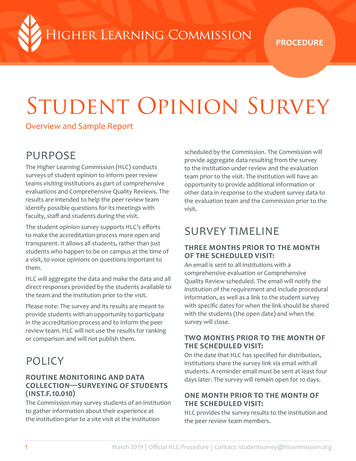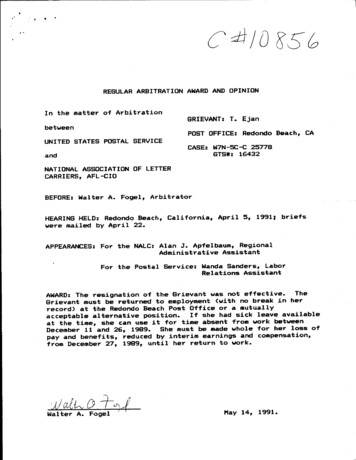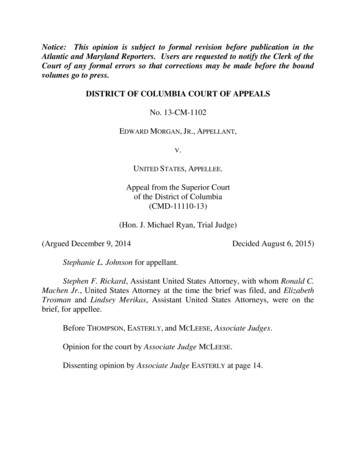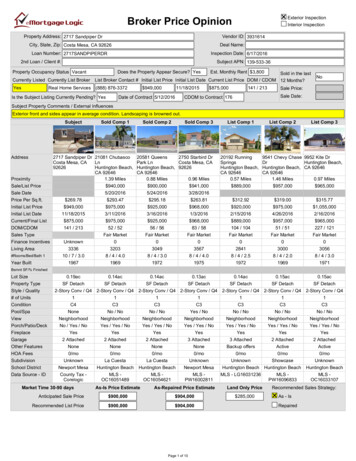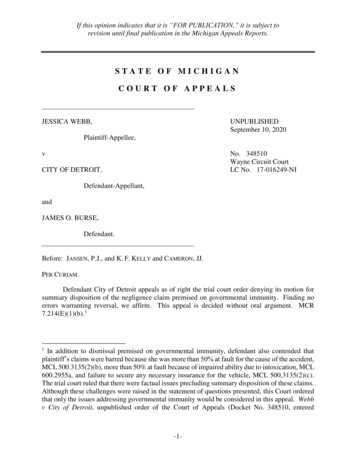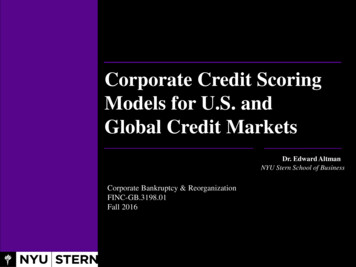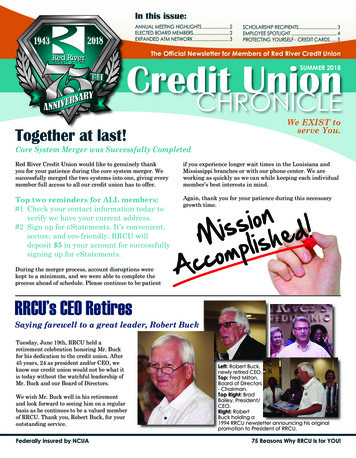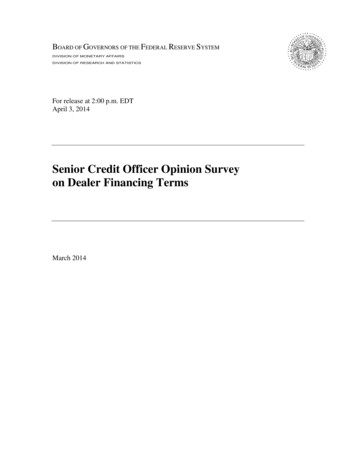
Transcription
BOARD OF GOVERNORS OF THE FEDERAL RESERVE SYSTEMDIVISION OF MONETARY AFFAIRSDIVISION OF RESEARCH AND STATISTICSFor release at 2:00 p.m. EDTApril 3, 2014Senior Credit Officer Opinion Surveyon Dealer Financing TermsMarch 2014
The March 2014 Senior Credit Officer Opinion Surveyon Dealer Financing TermsSummaryThe March 2014 Senior Credit Officer Opinion Survey on Dealer Financing Termscollected qualitative information on changes over the previous three months in creditterms and conditions in securities financing and over-the-counter (OTC) derivativesmarkets. In addition to the core set of questions, this survey included a set of specialquestions about the use of synthetic prime brokerage (synthetic PB) by hedge fund clientsas an alternative to traditional secured financing to provide levered exposure to securities.The 22 institutions participating in the survey account for almost all of the dealerfinancing of dollar-denominated securities provided to nondealers and are the most activeintermediaries in OTC derivatives markets. The survey was conducted during the periodbetween February 18, 2014, and March 3, 2014. The core questions asked about changesbetween December 2013 and February 2014. 1Responses to the core questions in the March survey suggested little change overthe past three months in the credit terms applicable to most classes of counterpartiescovered by the survey. However, results offered a few insights regarding recentdevelopments and current areas of focus in dealer-intermediated markets: A net fraction of about one-third of respondents—the lowest value since thisquestion was added to the survey in September 2011—reported an increase in theamount of resources and attention devoted to the management of concentratedexposures to central counterparties and other financial market utilities. The use of financial leverage by the counterparties covered in the survey wasgenerally reported to be unchanged over the past three months; however, about1For questions that ask about credit terms, reported net percentages equal the percentage ofinstitutions that reported tightening terms (“tightened considerably” or “tightened somewhat”) minus thepercentage of institutions that reported easing terms (“eased considerably” or “eased somewhat”). Forquestions that ask about demand, reported net fractions equal the percentage of institutions that reportedincreased demand (“increased considerably” or “increased somewhat”) minus the percentage of institutionsthat reported decreased demand (“decreased considerably” or “decreased somewhat”).1
Board of Governors of the Federal Reserve Systemtwo-fifths of dealers pointed to a decline with respect to trading real estateinvestment trusts (REITs). 2 With regard to securities financing, nearly one-half of dealers reported an increasein demand for funding of non-agency residential mortgage-backed securities(RMBS), and two-fifths of respondents also noted increased demand for termfunding against such collateral. Dealers assessed liquidity and functioning ashaving improved in the non-agency RMBS market, while conditions in the cashmarkets for other collateral types were reported to be basically unchanged. In their responses to the special questions about synthetic PB, dealers indicatedthat use of this alternative to margin loans and repo refinancing variedconsiderably across the hedge fund types specified in the survey. Equity longshort hedge funds that are fundamentally oriented were listed as the biggest users.Access to foreign markets was given as the most important motivation, withnearly three-fourths of dealers indicating it was very important. Notably,availability of leverage was listed as being unimportant by almost one-half ofrespondents.Counterparty Types(Questions 1–40)Dealers and Other Financial Intermediaries. Nineteen of the 22 respondents to theMarch survey reported that the amount of resources and attention devoted to themanagement of concentrated credit exposure to dealers and other financial intermediariesremained basically unchanged over the past three months, while the remainder pointed toan increase. (See the exhibit “Management of Concentrated Credit Exposures andIndicators of Supply of Credit.”) The share of dealers reporting an increase was broadlysimilar to that in recent surveys, and remained well below the 90 percent peak reached inthe December 2011 survey.Central Counterparties and Other Financial Utilities. About one-third ofrespondents, on net, noted that they had increased the amount of resources and attentiondevoted to the management of concentrated credit exposures to central counterparties andother financial utilities over the past three months. This percentage was the lowestobserved since the question was introduced in September 2011. As in the Decembersurvey, about one-fourth of respondents indicated that changes in the practices of centralcounterparties, including changes in margin requirements and haircuts, had someinfluence on the credit terms applied to clients on bilateral transactions that are notcleared.2Trading REITs, including agency REITs, invest in assets backed by real estate rather thandirectly in real estate.2
Senior Credit Officer Opinion SurveyHedge Funds. As in the past several surveys, respondents in March generally noted thatboth price terms (such as financing rates) and nonprice terms (including haircuts,maximum maturity, covenants, cure periods, cross-default provisions, or otherdocumentation features) offered to hedge funds for securities financing and OTCderivatives transactions were basically unchanged over the past three months. Dealersalso reported that the use of financial leverage by hedge funds and the availability ofadditional (and currently not utilized) financial leverage under agreements currently inplace with hedge funds over the past three months had remained basically unchanged.(See the exhibit “Use of Financial Leverage.”) Most dealers indicated that the provisionof differential terms to most-favored clients and the intensity of efforts to negotiate morefavorable price and nonprice terms had remained basically unchanged over the past threemonths, though about one-fifth of firms reported an increased intensity of efforts tonegotiate better terms.Trading Real Estate Investment Trusts. Similar to the December survey, nearly onefifth of respondents reported having tightened nonprice terms offered to trading REITs.However, all but one respondent to the March survey indicated that price terms offered totrading REITs had remained basically unchanged over the past three months. Two-fifthsof dealers noted that the use of financial leverage by trading REITs had decreasedsomewhat over the past three months, continuing a trend that began last summer.Provision of differential terms to most-favored clients and the intensity of efforts byclients to negotiate more-favorable terms were reported to be generally little changed onbalance.Mutual Funds, Exchange-Traded Funds, Pension Plans, and Endowments. As in thepast few surveys, respondents to the March survey indicated that both price and nonpriceterms offered to mutual funds, exchange-traded funds (ETFs), pension plans, andendowments had remained basically unchanged over the past three months. Provision ofdifferential terms to most-favored clients and the intensity of efforts by clients tonegotiate more-favorable terms also were reported to be little changed, as was the use offinancial leverage.Insurance Companies. As in recent surveys, respondents to the March survey noted thatboth price and nonprice terms offered to insurance companies had changed little over thepast three months. Provision of differential terms to most-favored clients and theintensity of efforts by clients to negotiate more-favorable terms also were reported to belittle changed, as was the use of financial leverage.Separately Managed Accounts Established with Investment Advisers. Nearly all ofthe dealers indicated that, as in recent surveys, price and nonprice terms negotiated byinvestment advisers on behalf of separately managed accounts were basically unchangedover the past three months. Provision of differential terms to most-favored clients,intensity of efforts to negotiate more-favorable terms, and the use of financial leverage byinvestment advisers were also reported to be basically unchanged.3
Board of Governors of the Federal Reserve SystemNonfinancial Corporations. Respondents to the March survey noted that, on balance,price and nonprice terms offered to nonfinancial corporations had remained basicallyunchanged over the past three months. As in the December survey, about one-fourth ofrespondents reported an increase in the intensity of efforts by nonfinancial corporations tonegotiate more-favorable price and nonprice terms.Mark and Collateral Disputes. The vast majority of respondents in March indicatedthat, as in recent surveys, the volume, persistence, and duration of mark and collateraldisputes with each counterparty type included in the survey were little changed, onbalance, over the past three months. However, a few respondents noted a decrease in theduration and persistence of disputes with dealers and other financial intermediaries.Over-the-Counter Derivatives(Questions 41–51)The nonprice terms incorporated in new or renegotiated OTC derivatives masteragreements were reported to be basically unchanged, on balance, over the past threemonths. 3 In addition, similar to the December survey, nearly all of the respondentsindicated in March that initial margins (which fall outside the scope of masteragreements) had remained basically unchanged over the past three months for bothaverage and most-favored clients and for all contract types included in the survey.Posting of nonstandard collateral—that is, collateral other than cash and U.S. Treasurysecurities—also remained basically unchanged. For most contract types, the volume,duration, and persistence of mark and collateral disputes were reported to be basicallyunchanged over the past three months.Securities Financing(Questions 52–79) 4Dealers reported that the credit terms under which most types of securities included in thesurvey are financed were little changed, on balance, over the past three months.However, a few dealers noted that the maximum amount of funding provided for highgrade corporate bonds had decreased somewhat.Nearly one-half of dealers reported an increase in demand for funding of nonagency RMBS. (See the exhibit “Measures of Demand for Funding and MarketFunctioning.”) Two-fifths of respondents also noted increased demand for term3The survey asks specifically about requirements, timelines, and thresholds for posting additionalmargin, acceptable collateral, recognition of portfolio or diversification benefits, triggers and covenants,and other documentation features, including cure periods and cross-default provisions.4Question 80, not discussed here, was optional and allowed respondents to provide additionalcomments.4
Senior Credit Officer Opinion Surveyfunding—that is, funding with a maturity greater than 30 days, against such collateral.For other collateral types covered in the survey, demand for funding had remainedbasically unchanged.For most collateral types, respondents generally noted that the liquidity andfunctioning of the underlying markets remained basically unchanged over the past threemonths. 5 However, one-third of respondents noted improved liquidity and functioning inthe non-agency RMBS market. Finally, as in previous surveys, nearly all of therespondents indicated that the volume, duration, and persistence of mark and collateraldisputes were basically unchanged for all of the collateral types.Special Questions on Synthetic Prime Brokerage(Questions 81–83)A set of special questions in the March survey queried dealers about the use of syntheticPB by their hedge fund clients. 6 Respondents reported that the use of synthetic PB variedwidely across different types of hedge funds. Equity long-short hedge funds that arefundamentally oriented were listed as the biggest users, with one-half of dealersindicating that synthetic PB was widely employed by a large number of clients and anadditional one-third of respondents pointing to use by some clients or in some situations.Fractions of dealers ranging between about one-half and about two-thirds noted thatsynthetic PB was either widely used by a large number of clients or was employed bysome clients or in some situations for the other three categories of equity funds coveredin the survey as well as for macro-oriented hedge funds. Emerging market–and creditoriented hedge funds were reported as making relatively little use of synthetic PB.About one-third of dealers indicated that the use of synthetic PB had increasedover the past year for the types of hedge fund clients that were currently seen as usingthese kinds of arrangements more intensively—that is, the various categories of equityhedge funds and macro-oriented hedge funds. By contrast, little change in the use ofsynthetic PB was reported for credit- and emerging market–oriented hedge funds.5Note that survey respondents are instructed to report changes in liquidity and functioning in themarket for the underlying collateral to be funded through repurchase agreements and similar securedfinancing transactions, not changes in the funding market itself. This question is not asked with respect toequity markets in the core questions.6The survey asked about different types of hedge fund clients and divided hedge funds into sevencategories: Equity long-short hedge funds (fundamentally oriented), equity long-short hedge funds(quantitatively oriented), event-driven equity funds, other equity funds, macro-oriented hedge funds, creditoriented hedge funds, and emerging market–oriented hedge funds.5
Board of Governors of the Federal Reserve SystemRespondents were also asked about several possible motivations for hedge funds’use of synthetic PB. 7 Nearly three-fourths of respondents indicated that access to foreignmarkets was very important, making it the most significant motivation of the optionslisted. About one-third of dealers pointed to tax considerations and ease in establishingand maintaining short positions as very important reasons. Of note, availability ofleverage was listed as being unimportant by almost one-half of the respondents.This document was prepared by Kurt Lewis, Division of Monetary Affairs, Board ofGovernors of the Federal Reserve System. Assistance in developing and administeringthe survey was provided by staff members in the Statistics Function and the MarketsGroup at the Federal Reserve Bank of New York.7Respondents were asked to list the importance of each of these possible motivations: Taxconsiderations, access to foreign markets, ease in establishing and maintaining short positions, avoidance oflimitations on rehypothecation of collateral, availability of greater leverage, ease in adjusting exposures,and ease in establishing exposure to non-dollar-denominated assets in dollars.6
Management of Concentrated Credit Exposures and Indicators of Supply of CreditRespondents increasing resources and attention to management of concentrated exposures to:Net percentageNet percentage100Dealers100Central counterparties 20132014Respondents tightening price terms to:Net percentageNet percentage80Hedge fundsTrading REITs Mutual funds* 80Insurance companiesSeparately managed accounts Nonfinancial 0122013-60201420102011201220132014Respondents tightening nonprice terms to:Net percentageNet percentage80Hedge fundsTrading REITs Mutual funds* 80Insurance companiesSeparately managed accounts Nonfinancial 0122013-6020142010 This question was added in the September 2011 survey.* Includes mutual funds, exchange-traded funds, pension plans, and endowments.72011201220132014
Use of Financial LeverageRespondents reporting increased use of leverage by:Net percentageNet percentage40Hedge funds40Trading 01020112012Net percentage2014Net percentage40Insurance companies201340Separately managed 14201020112012Net percentage2014Net percentage40Mutual fundsExchange-traded funds201340Pension 13-6020142010Note: This question was added in the September 2011 survey.82011201220132014
Measures of Demand for Funding and Market FunctioningRespondents reporting increased demand for funding of:Net percentageNet percentage80High-grade corporate bondsHigh-yield corporate bonds 80EquitiesCMBS 20112012Net percentage2014Net percentage80Agency RMBSNon-agency RMBS 201380Consumer ABS 2011201220132014Respondents reporting an improvement in liquidity and functioning in the underlying markets for:Net percentageNet percentage100High-grade corporate bondsHigh-yield corporate bonds CMBS 100Agency RMBSNon-agency RMBS Consumer ABS 22013-8020142010 This question was added in the September 2011 survey.92011201220132014
Senior Credit Officer Opinion SurveyResults of the March 2014 Senior Credit OfficerOpinion Survey on Dealer Financing TermsThe following results include the original instructions provided to the surveyrespondents. Please note that percentages are based on the number of financialinstitutions that gave responses other than “Not applicable.” Components may not addto totals due to rounding.Counterparty TypesQuestions 1 through 40 ask about credit terms applicable to, and mark and collateraldisputes with, different counterparty types, considering the entire range of securitiesfinancing and over-the-counter (OTC) derivatives transactions. Question 1 focuses ondealers and other financial intermediaries as counterparties; questions 2 and 3 on centralcounterparties and other financial utilities; questions 4 through 10 focus on hedge funds;questions 11 through 16 on trading real estate investment trusts (REITs);questions 17 through 22 on mutual funds, exchange-traded funds (ETFs), pension plans,and endowments; questions 23 through 28 on insurance companies;questions 29 through 34 on separately managed accounts established with investmentadvisers; and questions 35 through 38 on nonfinancial corporations. Questions 39 and 40ask about mark and collateral disputes for each of the aforementioned counterparty types.In some questions, the survey differentiates between the compensation demandedfor bearing credit risk (price terms) and the contractual provisions used to mitigateexposures (nonprice terms). If your institution’s terms have tightened or eased over thepast three months, please so report them regardless of how they stand relative to longerterm norms. Please focus your response on dollar-denominated instruments; if materialdifferences exist with respect to instruments denominated in other currencies, pleaseexplain in the appropriate comment space. Where material differences exist acrossdifferent business areas—for example, between traditional prime brokerage and OTCderivatives—please answer with regard to the business area generating the most exposureand explain in the appropriate comment space.10
Board of Governors of the Federal Reserve SystemDealers and Other Financial Intermediaries1. Over the past three months, how has the amount of resources and attention yourfirm devotes to management of concentrated credit exposure to dealers and otherfinancial intermediaries (such as large banking institutions) changed?Increased considerablyIncreased somewhatRemained basically unchangedDecreased somewhatDecreased considerablyTotalNumber ofRespondents03190022Percent0.013.686.40.00.0100.0
Special Questions on Synthetic Prime Brokerage (Questions 81–83) A set of special questions in the March survey queried dealers about the use of synthetic PB by their hedge fund clients. 6. Respondents reported that the use of synthetic PB varied widely across different typ
